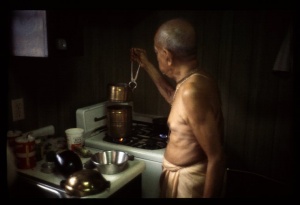CC Madhya 25.97: Difference between revisions
m (1 revision(s)) |
No edit summary |
||
| Line 1: | Line 1: | ||
{{ | [[Category:Sri Caitanya-caritamrta - Madhya-lila Chapter 25|C097]] | ||
<div style="float:left">'''[[Sri Caitanya-caritamrta|Śrī Caitanya-caritāmṛta]] - [[CC Madhya|Madhya-līlā]] - [[CC Madhya 25|Chapter 25: How All the Residents of Vārāṇasī Became Vaiṣṇavas]]'''</div> | |||
<div style="float:right">[[File:Go-previous.png|link=CC Madhya 25.96|Madhya-līlā 25.96]] '''[[CC Madhya 25.96|Madhya-līlā 25.96]] - [[CC Madhya 25.98|Madhya-līlā 25.98]]''' [[File:Go-next.png|link=CC Madhya 25.98|Madhya-līlā 25.98]]</div> | |||
{{CompareVersions|CC|Madhya 25.97|CC 1975|CC 1996}} | |||
{{RandomImage}} | |||
==== TEXT 97 ==== | ==== TEXT 97 ==== | ||
<div class="verse"> | |||
<div | :"ei artha-āmāra sūtrera vyākhyānurūpa | ||
:'bhāgavata' kariba sūtrera bhāṣya-svarūpa" | |||
</div> | </div> | ||
| Line 13: | Line 16: | ||
==== SYNONYMS ==== | ==== SYNONYMS ==== | ||
<div class="synonyms"> | |||
<div | ''ei artha''—this explanation; ''āmāra''—my; ''sūtrera''—of the ''Brahma-sūtra''; ''vyākhyā-anurūpa''—a suitable explanation; ''bhāgavata''—Śrīmad-Bhāgavata Purāṇa; ''kariba''—I shall make; ''sūtrera''—of the ''Brahma-sūtra''; ''bhāṣya-svarūpa''—as the original commentary. | ||
ei | |||
</div> | </div> | ||
| Line 21: | Line 23: | ||
==== TRANSLATION ==== | ==== TRANSLATION ==== | ||
<div class="translation"> | |||
<div | "Śrīla Vyāsadeva considered that whatever he had received from Nārada Muni as an explanation of oṁkāra he would elaborately explain in his book Śrīmad-Bhāgavatam as a commentary on the Brahma-sūtra. | ||
</div> | </div> | ||
==== PURPORT ==== | ==== PURPORT ==== | ||
<div class="purport"> | |||
The sound vibration ''oṁkāra'' is the root of Vedic knowledge. ''Oṁkāra'' is known as the ''mahā-vākya'', or supreme sound. Whatever meaning is in the supreme sound ''oṁkāra'' is further understood in the Gāyatrī ''mantra''. Again, this same meaning is explained in [[Srimad-Bhagavatam|''Śrīmad-Bhāgavatam'']] in the four ''ślokas'' known as the ''catuḥ-ślokī'', which begin with the words ''ahaṁ evāsam evāgre''. The Lord says, "Only I existed before the creation." From this statement, four ''ślokas'' have been composed, and these are known as the ''catuḥ-ślokī'' ([[SB 2.9.33|SB 2.9.33/34/35/36]]). In this way the Supreme Personality of Godhead informed Lord Brahmā about the purport of the ''catuḥ-ślokī''. Again, Lord Brahmā explained this to Nārada Muni, and Nārada Muni explained it to Śrīla Vyāsadeva. This is the ''paramparā'' system, the disciplic succession. The import of Vedic knowledge, the original word ''praṇava'', has been explained in [[Srimad-Bhagavatam|''Śrīmad-Bhāgavatam'']]. The conclusion is that the ''Brahma-sūtra'' is explained in [[Srimad-Bhagavatam|''Śrīmad-Bhāgavatam'']]. | |||
</div> | |||
<div | <div style="float:right; clear:both;">[[File:Go-previous.png|link=CC Madhya 25.96|Madhya-līlā 25.96]] '''[[CC Madhya 25.96|Madhya-līlā 25.96]] - [[CC Madhya 25.98|Madhya-līlā 25.98]]''' [[File:Go-next.png|link=CC Madhya 25.98|Madhya-līlā 25.98]]</div> | ||
__NOTOC__ | |||
</div> | __NOEDITSECTION__ | ||
__NOTOC__ | |||
Revision as of 06:39, 17 September 2021

A.C. Bhaktivedanta Swami Prabhupada
TEXT 97
- "ei artha-āmāra sūtrera vyākhyānurūpa
- 'bhāgavata' kariba sūtrera bhāṣya-svarūpa"
SYNONYMS
ei artha—this explanation; āmāra—my; sūtrera—of the Brahma-sūtra; vyākhyā-anurūpa—a suitable explanation; bhāgavata—Śrīmad-Bhāgavata Purāṇa; kariba—I shall make; sūtrera—of the Brahma-sūtra; bhāṣya-svarūpa—as the original commentary.
TRANSLATION
"Śrīla Vyāsadeva considered that whatever he had received from Nārada Muni as an explanation of oṁkāra he would elaborately explain in his book Śrīmad-Bhāgavatam as a commentary on the Brahma-sūtra.
PURPORT
The sound vibration oṁkāra is the root of Vedic knowledge. Oṁkāra is known as the mahā-vākya, or supreme sound. Whatever meaning is in the supreme sound oṁkāra is further understood in the Gāyatrī mantra. Again, this same meaning is explained in Śrīmad-Bhāgavatam in the four ślokas known as the catuḥ-ślokī, which begin with the words ahaṁ evāsam evāgre. The Lord says, "Only I existed before the creation." From this statement, four ślokas have been composed, and these are known as the catuḥ-ślokī (SB 2.9.33/34/35/36). In this way the Supreme Personality of Godhead informed Lord Brahmā about the purport of the catuḥ-ślokī. Again, Lord Brahmā explained this to Nārada Muni, and Nārada Muni explained it to Śrīla Vyāsadeva. This is the paramparā system, the disciplic succession. The import of Vedic knowledge, the original word praṇava, has been explained in Śrīmad-Bhāgavatam. The conclusion is that the Brahma-sūtra is explained in Śrīmad-Bhāgavatam.